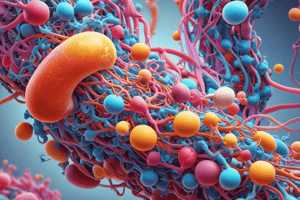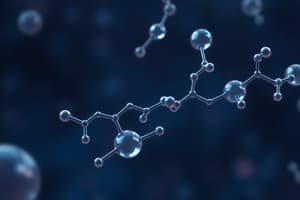Podcast
Questions and Answers
Which of these is the primary reason fats are efficient for long-term energy storage?
Which of these is the primary reason fats are efficient for long-term energy storage?
- They are highly oxidized.
- They are quickly broken down into glucose.
- They are not solvated and are highly reduced. (correct)
- They are easily solvated in water.
The breakdown of fatty acids via beta oxidation occurs in the cytoplasm.
The breakdown of fatty acids via beta oxidation occurs in the cytoplasm.
False (B)
What molecule is formed from excess acetyl-CoA during gluconeogenesis when oxaloacetate is depleted, potentially leading to ketoacidosis?
What molecule is formed from excess acetyl-CoA during gluconeogenesis when oxaloacetate is depleted, potentially leading to ketoacidosis?
ketone bodies
Fatty acid biosynthesis utilizes ______ instead of CoA.
Fatty acid biosynthesis utilizes ______ instead of CoA.
Match the following enzymes with their roles in fatty acid metabolism:
Match the following enzymes with their roles in fatty acid metabolism:
What carries acetyl-CoA equivalents across the mitochondrial membrane for fatty acid biosynthesis?
What carries acetyl-CoA equivalents across the mitochondrial membrane for fatty acid biosynthesis?
Direct absorption of dietary fats by intestinal cells is a primary step in stage I metabolism.
Direct absorption of dietary fats by intestinal cells is a primary step in stage I metabolism.
What is the correct sequence of steps in the redox series of a fatty-acid beta-carbon during lipogenesis?
What is the correct sequence of steps in the redox series of a fatty-acid beta-carbon during lipogenesis?
Attaching coenzyme A to a fatty acid to enable its catabolism is termed ______.
Attaching coenzyme A to a fatty acid to enable its catabolism is termed ______.
Through what mechanism does the amino acid derivative carnitine participate in fatty acid metabolism?
Through what mechanism does the amino acid derivative carnitine participate in fatty acid metabolism?
Amino acids are primarily absorbed in the stomach.
Amino acids are primarily absorbed in the stomach.
What is the name of the system that regulates protein degradation in cells?
What is the name of the system that regulates protein degradation in cells?
In a state of positive nitrogen balance, excess nitrogen is excreted as ______.
In a state of positive nitrogen balance, excess nitrogen is excreted as ______.
Which reactions are central to amino acid catabolism?
Which reactions are central to amino acid catabolism?
An acetyl group from acetyl-CoA can directly contribute to carbamoyl phosphate synthesis.
An acetyl group from acetyl-CoA can directly contribute to carbamoyl phosphate synthesis.
Name two pathways into which carbamoyl phosphate feeds.
Name two pathways into which carbamoyl phosphate feeds.
Animals obtain nitrogen from dietary proteins, but plants can use ______ directly.
Animals obtain nitrogen from dietary proteins, but plants can use ______ directly.
Which enzyme, essential for nitrogen fixation, is oxygen-sensitive?
Which enzyme, essential for nitrogen fixation, is oxygen-sensitive?
The anabolism of all amino acids requires the use of acetyl-CoA.
The anabolism of all amino acids requires the use of acetyl-CoA.
From which two molecules does the anabolism of heme begin?
From which two molecules does the anabolism of heme begin?
Flashcards
Hormone sensitive lipase
Hormone sensitive lipase
Mobilizes stored fat
Beta oxidation
Beta oxidation
Breaks down fatty acids in a stepwise redox process at the beta-carbon
Acetyl-CoA carboxylase (ACC)
Acetyl-CoA carboxylase (ACC)
Converts acetyl-CoA into malonyl-CoA, committing it to fatty acid biosynthesis
Fatty acid synthase
Fatty acid synthase
Signup and view all the flashcards
ACC regulation
ACC regulation
Signup and view all the flashcards
Redox series of beta-carbon during beta oxidation
Redox series of beta-carbon during beta oxidation
Signup and view all the flashcards
Steps required for fat mobilization
Steps required for fat mobilization
Signup and view all the flashcards
Ubiquitin-proteasome system
Ubiquitin-proteasome system
Signup and view all the flashcards
Aminotransferase reactions
Aminotransferase reactions
Signup and view all the flashcards
Nitrogen Sources
Nitrogen Sources
Signup and view all the flashcards
Glutamate and glutamine synthesis
Glutamate and glutamine synthesis
Signup and view all the flashcards
Role of Vitamins in Metabolism
Role of Vitamins in Metabolism
Signup and view all the flashcards
Compartmentalization of Metabolism
Compartmentalization of Metabolism
Signup and view all the flashcards
Redox Reactions in Energy Metabolism
Redox Reactions in Energy Metabolism
Signup and view all the flashcards
Acetyl-CoA
Acetyl-CoA
Signup and view all the flashcards
Purpose of Metabolism
Purpose of Metabolism
Signup and view all the flashcards
Electron Transport Chain
Electron Transport Chain
Signup and view all the flashcards
Oxygen as Final Electron Acceptor
Oxygen as Final Electron Acceptor
Signup and view all the flashcards
Role of the Proton Gradient
Role of the Proton Gradient
Signup and view all the flashcards
Commonality: oxid. phos, photosyn.
Commonality: oxid. phos, photosyn.
Signup and view all the flashcards
Study Notes
Fatty Acid Metabolism
- Fats are efficient for long-term energy storage because they are highly reduced and not solvated
- Dietary fats are emulsified by bile salts and broken down by lipases
- The resulting products are reassembled into triacylglycerols (TAGs)
- TAGs are then delivered in chylomicrons
- Glucagon activates hormone-sensitive lipase that mobilizes stored fat
- Fatty acids are activated for breakdown by fatty acyl-CoA synthetase with ATP
- This activation results in the formation of fatty acyl-CoA
- Carnitine is required for fatty acids to cross the mitochondrial membrane
- Beta oxidation is a stepwise redox process that breaks down fatty acids at the beta-carbon
- Beta oxidation produces NADH, FADH2, and acetyl-CoA.
- Oxaloacetate depletion during gluconeogenesis limits the citric acid cycle
- Excess acetyl-CoA is converted into ketone bodies
- An overproduction of ketone bodies can lead to ketoacidosis
- Acetyl-CoA carboxylase (ACC) converts acetyl-CoA into malonyl-CoA
- This conversion commits acetyl-CoA to fatty acid biosynthesis
- Acyl carrier protein (ACP) is used instead of CoA in fatty acid biosynthesis
- Fatty acid synthase catalyzes step-by-step reductions of the beta carbon
- Citrate transports acetyl-CoA equivalents across the mitochondrial membrane for biosynthesis
- AMP-dependent kinase regulates ACC and is identified as a potential drug target for obesity
- Dietary fats are emulsified, digested, and repackaged before entering lymphatic circulation, rather than direct absorption by intestinal cells
- Acyl Carrier Protein (ACP) is the "handle" used for fatty-acid biosynthesis
- The redox series steps of a fatty-acid beta-carbon during lipogenesis are Reduction → Dehydration → Reduction
- Fatty acid activation is the attachment of coenzyme A to a fatty acid for catabolism
- Carnitine is an amino acid derivative that is used for fatty-acid translocation
- The redox series of a fatty-acid beta-carbon during beta oxidation is Oxidation → Hydration → Oxidation → Thiolysis
- Fat mobilization steps: Hormone (glucagon/epinephrine) → cAMP → PKA → hormone-sensitive lipase → TAG breakdown
- Potential drug targets for obesity that are being investigated: AMP-dependent kinase and acetyl-CoA carboxylase (ACC)
- Metabolizing the twenty-carbon fatty acid arachidonate yields 10 acetyl-CoA, 9 FADH2, and 9 NADH
- During fatty-acid biosynthesis, acetyl-carbons from acetyl-CoA cross the inner mitochondrial membrane as citrate
Protein Catabolism
- Proteins are denatured in the stomach, digested in the intestine, and amino acids are absorbed
- Dietary amino acids mainly replenish amino acids lost during protein turnover
- Protein degradation is regulated by the ubiquitin-proteasome system
- Protein deficiency or malnourishment may result in a negative nitrogen balance
- The excess nitrogen in positive nitrogen balance is excreted as urea
- Aminotransferase reactions are central to amino acid catabolism
- Glutamate is a central molecule in nitrogen metabolism
- Glutamate can be directly deaminated
- Carbamoyl phosphate is produced from ammonia from deamination
- The urea cycle combines ammonia, from carbamoyl phosphate, and aspartate to create urea
- Amino acid carbon skeletons can be glucogenic or ketogenic
- Glutamate is converted to α-ketoglutarate, Aspartate is converted to oxaloacetate, and Alanine is converted to pyruvate
- Other amino acids are converted to CAC intermediates
- Methionine to SAM (S-adenosyl methionine) acts as a major methyl donor
- Phenylalanine to tyrosine occurs unless an enzyme is defective, which results in PKU
- The macromolecule made with amino acids from dietary protein is protein
- The ubiquitin-proteasome system is the molecular process that allows for protein turnover
- Methionine is the amino acid in whose catabolic pathway the methyl donor, abbreviated SAM, is made
- Phenylalanine is the amino acid substrate of the enzyme encoded by the gene that is mutated in the genetic disorder PKU
- Surplus nitrogen in a state of positive nitrogen balance is excreted as urea
- Digestion of the peptide bonds in dietary proteins starts in the stomach
- An acetyl group from acetyl-CoA connot contribute to carbamoyl phosphate
- Protein deficient or calorie-only malnutrition can cause protein deficiency disease
- Carbamoyl phosphate feeds into the urea cycle and pyrimidine synthesis
- Phenylalanine, Isoleucine, Threonine, Tryptophan, and Tyrosine: are the amino acids that can be made into glucose and acetyl-CoA
Amino Acid Anabolism
- Animals obtain nitrogen from dietary proteins
- Plants can use ammonia, while some bacteria fix N₂
- Nitrogen fixation via nitrogenase and nitrogenase reductase is sensitive to oxygen
- Glutamate is created by glutamate dehydrogenase
- Glutamine is created by glutamine synthetase
- Pyruvate, oxaloacetate, and α-ketoglutarate yields alanine, aspartate, and glutamate
- Other amino acids are created from energy metabolism intermediates
- Essential amino acids require longer synthetic pathways
- Aminotransfer describes a core biosynthetic reaction
- Amino acids yield biogenic amines through decarboxylation
- Glycine plus intermediates yields heme
- Heme yields bilirubin (a bilin), which is excreted in bile
- Tryptophan requires the longest anabolic pathway
- Jaundice results from heme catabolism, due to the accumulation of bilirubin
- The anabolism of all amino acids fails to require acetyl-CoA
- The anabolism of heme begins with glycine and succinyl-CoA, then goes to ALA, then porphobilinogen, then protoporphyrin IX, then heme (with Fe²⁺)
Metabolism Overview
- Metabolism functions to provide energy and building blocks for cellular processes
- Adenosine Triphosphate (ATP) acts as the energy currency by storing and transferring energy to drive cellular work
- Catabolism breaks down molecules and releases energy, while anabolism synthesizes biomolecules and requires energy
- B-complex vitamins serve as cofactors in metabolic reactions
- Enzymes regulate reactions in metabolism in order to avoid metabolic equilibrium and maintain energy flow
- Metabolic pathways take place in unique cellular locations to regulate metabolic flux
- Unfavorable reactions are coupled with favorable reactions (e.g., ATP hydrolysis)
- Electron carriers such as NAD⁺ and FAD are involved in redox reactions
- Acetyl-CoA serves as a central metabolic intermediate, essential for both energy production and biosynthesis
- Metabolic pathways adjust constantly to energy and material demands
- The majority of metabolism is to provide cellular energy
- B-complex vitamins function as coenzymes
- ATP is the energy currency of cells because it powers almost all cellular work
- Metabolism encompasses the catabolic degradation of complex dietary compounds
- Some metabolism involves materials in our diet that we build ourselves from
- Compartmentalization, enzyme regulation, and coupling reactions are needed to avoid equilibrium in overall energy metabolism
- Anabolic biosynthesis of complex biomolecules are involved
- Metabolic pathways provide energy and building blocks for all life processes
- Anabolic pathways use energy and building blocks to make and do things
- Enzymes make unfavorable reactions take place spontaneously by coupling them with favorable reactions, like ATP hydrolysis
- Dinucleotides NAD and FAD are used in redox reactions
- Acetyl-CoA describes the “central compound of energy metabolism"
- True, the use of metabolism is to provide energy for doing unfavorable things
- Metabolism involves "stuff", the stuff to build with and the stuff that's made
- Catabolic pathways release energy and provide building blocks
- Equilibrium of energy metabolism is avoided by enzyme regulation and substrate flux
- Coenzyme A, NAD⁺, and FAD contain a B vitamin and an adenosine nucleotide
Oxidative Phosphorylation
- The electron transport chain (ETC) is a series of protein complexes
- The ETC's protein complexes transfer electrons to oxygen, generating a proton gradient
- The proton gradient in the ETC powers ATP synthesis
- The proton gradient can generate heat via uncoupling proteins
- Complexes I-IV in the ETC transfer electrons from NADH and FADH₂ to oxygen while pumping protons
- Ubiquinone (Q) and cytochrome c are electron carriers in the ETC that shuttle electrons between complexes
- The Q cycle is a mechanism in Complex III that enables electron transfer from ubiquinone to cytochrome c
- The chemiosmotic hypothesis: ATP is produced when protons travel back into the mitochondrial matrix through ATP synthase
- ATP synthase (F₁F₀ Complex): a rotary motor enzyme that produces ATP through the proton gradient
- Coupling the proton gradient to ATP synthesis: the proton-motive force powers ATP production through oxidative phosphorylation
- Proteins allowing proton leakage reduce ATP production and generate heat
- Oxygen serves as the final electron acceptor, receiving electrons and protons to produce water
- Compare function and electron donors/acceptors between ETC Complexes I-IV for their differences
- Ionophores and ETC disruptors dissipate the proton gradient, uncoupling ATP synthesis
- Compare mitochondrial and chloroplast ATP synthases similarities and differences in oxidative phosphorylation and photosynthesis
- ETC proteins provide insights into evolutionary relationships among organisms
- Gradient-driven rotary motors harness energy from gradients to power molecular machines
- The biggest difference between Complex II and other ETC complexes: Complex II fails to pump protons
- The proton gradient provides the energy for oxidative phosphorylation of ATP
- The ETC-created proton gradients drives ATP synthesis via chemiosmosis
- NADH, FADH2, ubiquinone (Q), and cytochrome c are electron carriers utilized in the ETC
- The coupling of proton gradient to oxidative phosphorylation by the ETC is Chemiosmotic coupling
- Uncoupling proteins can generate heat in the proton gradient
- Complex II does not interact with any diffusible electron carrier
- The chemiosmotic model proposes that a proton gradient across the inner mitochondrial membrane powers ATP synthesis.
- Complex III receives electrons from a lipid-soluble electron carrier and transfers them to a water-soluble protein using the Q cycle
- An electron will go through 3 complexes and 2 diffusible carriers once in the ETC before being dumped to oxygen
- Cytochrome c was important in providing support for evolutionary tree of life.
- The chemiosmotic hypothesis explains how the proton gradient is usually used
- ADP, ATP, phosphate, pyruvate, and other small metabolites are the compounds with transporters in the inner mitochondrial membrane
- Light reactions of photosynthesis, and mitochondrial electron transport chain and oxidative phosphorylation share use use of an electron transport chain to generate a proton gradient that drives ATP synthesis
- Cytochrome b6f complex is a multi-electron-carrier complex in the the electron transport chain of photosynthesis
- Both Complex III and Complex IV of the ETC pump protons and contain cytochromes
- The F1F0 ATP synthase and chloroplast ATP synthase are structurally and functionally homologous, both using a proton gradient to synthesize ATP
- In the waterwheel analogy, the proton pumps which are Complexes I, III, IV of the ETC are like paddles making them more efficient
- Ubiquinone (Q), cytochrome c, NADH, and FADH2 are the important carriers in the ETC
- Complex I takes electrons from NADH and gives them to ubiquinone (Q)
- The role of Complex IV in the electron transport chain is to transfer electrons to oxygen to form water and pumps protons
- Ionophore: facilitates ion transport across membranes and disrupts ion gradients
- The F1F0 ATP synthase is a rotary motor that synthesizes ATP using proton gradient energy
- Energy from the proton gradient can be used in a number of different ways
- The F1F0 ATP synthase is an example of a gradient-driven rotary motor
- Complex I pumps protons and uses NADH, unlike Complex II which uses FADH2 and does not pump protons
- Protein chemists and evolutionary biologists are greatly indebted to Cytochrome c.
- An uncoupling protein is a protein that allows protons to bypass ATP synthase, dissipating the gradient as heat
Studying That Suits You
Use AI to generate personalized quizzes and flashcards to suit your learning preferences.



